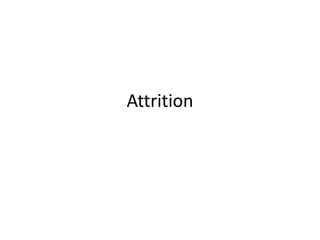37.attrition
•Transferir como PPTX, PDF•
5 gostaram•4,772 visualizações
Denunciar
Compartilhar
Denunciar
Compartilhar

Recomendados
Mais conteúdo relacionado
Mais procurados
Mais procurados (20)
Surveyor and technique of Surveying in Removable partial denture

Surveyor and technique of Surveying in Removable partial denture
The neutral zone concept in complete denture final

The neutral zone concept in complete denture final
Classification and configuration for fpd/dental courses

Classification and configuration for fpd/dental courses
Destaque (20)
Semelhante a 37.attrition
Semelhante a 37.attrition (20)
Regressive-alterations-(Part-1)-20208191434460.ppt

Regressive-alterations-(Part-1)-20208191434460.ppt
Orthodontic therapy to correct Malocclusion and dentofacial anomalies. Discuss

Orthodontic therapy to correct Malocclusion and dentofacial anomalies. Discuss
All about Dental Erosion | causes and prevention about dental erosion

All about Dental Erosion | causes and prevention about dental erosion
Mc Cracken chapter 1: Partially Edentulous, Physiology and Terminology.

Mc Cracken chapter 1: Partially Edentulous, Physiology and Terminology.
Early childhood caries, rampant, chronic and arrested caries

Early childhood caries, rampant, chronic and arrested caries
Mais de Nehal Vithlani
Mais de Nehal Vithlani (16)
37.attrition
- 1. Attrition
- 2. General information Physiologic wearing away of teeth because of tooth-to-tooth contact, as in mastication it plays an important physiological role as it may helps to maintain an advantageous Crown to root ratio and gains intercoronal space of 1 cm which facilitates third molar eruption attrition can be considered pathological when it causes functional, aesthetic and dental sensitivity problems
- 3. Types Physiological attrition – attrition which occurs due to normal ageing process, due to mastication pathological attrition – it occurs due to certain abnormalities in occlusion, chewing pattern or due to some structural defects in teeth
- 4. Aetiology Abnormal chewing habits – parafunctional chewing habits like bruxism and chronic persistent chewing of coarse and abrasive food or other substance like tobacco in certain occupations workers are exposed to an atmosphere of abrasive dust and cannot avoid it getting into mouth Millar Genesis imperfecta and dentinogenesis imperfecta, hardness of enamel and dentin is reduced and such teeth become more prone to attrition
- 5. Clinical features Men have a greater masticatory forces so have more attrition It occurs only on occlusal, incisal and proximal surfaces of teeth Small polished facet of a cusp tip Ridge and slight flattening of an incisal edge When the dentin gets exposed, it generally becomes discoloured that is Brown in colour There is gradual reduction In cusp height and consequent flattening of occlusal inclined plane
- 6. Radiographic features Smooth wearing of incisal and occlusal surfaces of involved teeth is evident by shortened Crown image Sclerosis of pulp chamber and canals is seen due to deposit shall of secondary dentin which narrows the pulp canals Widening of PDL space and hypercementosis Some loss of alveolar bone
- 7. Management Habit breaking appliance Correction of malocclusion, stoppage of tobacco chewing habit and restriction and diet to non-coarse food are usually done Management of sensitivity anaesthetics is done